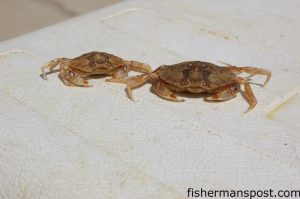Pro Angles Inshore – Capt. Mark Dickson

Crabs like these, either whole or sectioned, prove irresistable to springtime reds around inshore creeks, docks, and other structure.
Red drum represent some of the first reliable action that inshore anglers can find in the springtime, feeding around docks, oyster beds, rocks, drop-offs, and other structure from the shallow marsh creeks and bays to deeper structure along the ICW, rivers, and inlets. Anglers pursue the reds with soft baits, plugs, spoons, spinners, live mud minnows and shrimp, and a variety of other baits and lures, but North Myrtle Beach Capt. Mark Dickson uses one of the reds’ favorite natural foods to spell springtime success.
“A red’s got the best nose in town,” Dickson, who runs Shallow Minded Fishing Charters out of Harbourgate Marina, says. “If there’s a crab out there, he’s going to find it.”
Dickson utilizes crab baits for most of his spring drum charters, finding that whole or broken into pieces, the crustaceans often outproduce just about anything else, especially in the spring.
“I’ll take the larger crabs and break them into four pieces,” Dickson continues. “You can just pop the tops of the shells off the smaller ones and use them whole. As long as you break them open and get some scent out there, the reds will find them.”
His favorite way to fish is as simple as it is effective, letting the crabs’ succulent scent draw the reds in from a distance.
“I usually just dead-stick two rods with crabs off the back of the boat,” Dickson explains, “while my clients are on the bow casting Gulp baits or mud minnows. I’ll put them on either a Carolina rig with a 1/2 oz. or smaller weight, or just pinch a split shot on the line a little ways up from the hook. Either way works great.”
With his anglers actively prospecting for fish from the bow and the crabby flavor beckoning from the stern, it isn’t usually long before the rods start bending.
There’s often only one more effective bait than a hard crab for a spring red drum, Dickson says, and that’s a soft-shell crab.
“A lot of people don’t want to pay $4 apiece for them at the fish market,” he explains, “but when the crabs start molting, the reds go absolutely fool over them. I’ll take three with me on each trip, break them into four pieces so I get 12 baits out of them, and I can pretty much count on six fish off of them.”
That math is hard to argue with.
The reds’ love for crabs extends beyond even the real models.
“We catch a lot of fish on Gulp crabs, too,” Dickson reveals, “especially in the wintertime. You can fish them a lot of ways. They work great on an Old Bayside Heavy Hook rigged a little sideways so they kind of crawl along the bottom, just barely hooked onto a jighead, or on a Carolina rig so they can flutter up off the bottom a little bit.”
Dickson prefers the smaller 1” Gulp crabs in the winter and the 2” versions during springtime.
Oyster rocks, drains, and other structure in the area’s creek and bays are some of Dickson’s favorite places to set up for some spring crabbin’, but he recommends anglers not get locked into fishing small spots where they’ve previously found success.
“If you’ve caught fish in a particular creek,” he explains, “but they aren’t in the spot you thought they were, they probably aren’t far off. You’ve got to fish the whole area from one end to the other to find them.”
Another scenario where crab baits pay off for Dickson involves reds schooling under docks, a common situation in spring.
“A lot of times they’ll be under a dock and just break you off whenever you hook one,” he says. “You can break up a few crabs, set up upcurrent of the dock and toss them in, and let the smell draw the fish away from the structure.”
Dickson gets many of his crabs through relationships he’s cultivated with local crabbers, but he also purchases plenty at fish markets and recommends anglers who don’t know a crabber do the same or set their own pots.
Anglers interested in maximizing their odds of connecting with spring reds would do well to add crabbin’ to their repertoire of techniques, and reds aren’t the only fish who find a smelly crab hard to resist.
“You catch a lot of black drum on them, too,” Dickson said, “and I actually caught a 5 lb. speckled trout on one last week, the largest trout I’ve caught this year.”





